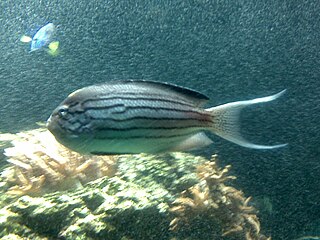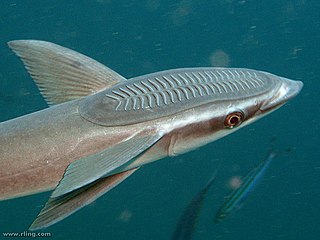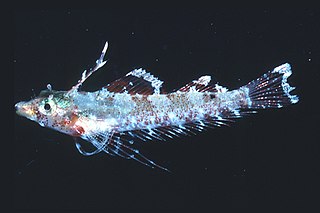
Pomacanthus is a genus of marine angelfish that is usually found around reefs and coral. Some of the notable places one can see these vari-coloured fish includes the Maldives, Sri Lanka, and Sipidan off the southern coast of Sabah, Malaysia. Generally the patterns and colors of these fish undergo a major transformation from juvenile to adult forms. The juveniles may even appear to be a different species.
Sauries are fish of the family Scomberesocidae. There are two genera, each containing two species. The name Scomberesocidae is derived from scomber and the Latin esox meaning pike.
Victor Gruschka Springer is Senior Scientist emeritus, Division of Fishes at the Smithsonian Institution's National Museum of Natural History in Washington, D.C. He is a specialist in the anatomy, classification, and distribution of fishes, with a special interest in tropical marine shorefishes. He has published numerous scientific studies on these subjects; also, a popular book called "Sharks in Question, the Smithsonian Answer Book" 1989.

Ruanoho is a genus of triplefin blennies. It is known from the southwestern Pacific Ocean off New Zealand. The generic name is a compound noun derived from the Māori rua meaning either "fish" or "hole" and noho meaning to "dwell" which refers to the habit of the species in this genus to shelter under rocks or within crevices.
Cololabis is a genus of sauries found in the eastern and northern Pacific Ocean. The name is derived from the Greek word kolos, meaning 'short', and the Latin word labis, meaning 'forceps', referring to the short beak of the type species Scombresox brevirostris.

Hemitaurichthys is a genus of marine ray-finned fish, butterflyfishes from the family Chaetodontidae. They are native to the Indian and Pacific oceans.

Genicanthus is a genus of marine angelfishes in the family Pomacanthidae. Known commonly as swallowtail or lyretail angelfish, these fishes are so-named for the distinctive shape of their tailfins. This genus of angels, in comparison to the other species found in hobby aquaria, are a good choice for beginners as they do not get nearly as large as some of the others. Another unique attribute is that swallowtail angels will tolerate each other and can be kept in pairs or as a single male with a harem, though it is typically best to add them to a tank at the same time. If added on by one, the angel which is added first may become aggressively territorial towards any new additions. Unlike others in the family Pomocanthidae, the angelfish species in the genus Genicanthus are generally considered to be reef safe. Also unlike most other members of the Pomacanthidae, those in Genicanthus are sexually dimorphic, meaning males and females are easily distinguishable. Fish in this species possess a small mouth relative to its size. This small mouth is well adapted for feeding on plankton in the water column. As planktivores, members of Genicanthus generally will not nip corals and sessile invertebrates.

Echeneis is a genus of fish in the family Echeneidae, the remoras. The genus is distributed in the Atlantic, Pacific and Indian Oceans.
Rhabdoblennius is a genus of combtooth blennies found in the Pacific Ocean, mostly in the western Pacific. The name of this genus is derived from the Greek word rhabdos meaning "stick" or "rod" and blennius meaning "mucus", referring to the absence of scales on the body of blennies.

Auchenionchus is a genus of labrisomid blennies endemic to the Pacific waters off of Chile.

Didogobius is a genus of small marine fish in the family Gobiidae, the true gobies. They are native to the eastern Atlantic Ocean and the Mediterranean Sea. The name of the genus is a compound noun made up of Dido, the mythical founder and first queen of Carthage, and the Latin gobius meaning "goby".

Enneapterygius mirabilis, the miracle triplefin, is a species of triplefin blenny in the genus Enneapterygius. It was described by Ronald Fricke in 1994 who gave it the specific name mirabilis, meaning "admirable", because its notable large pectoral fins and first dorsal fin were pretty.
Matanui is a genus of triplefin blennies, they are endemic to New Zealand.
Adelotremus is a small genus of combtooth blennies which are found in the Indo-Pacific region. The name of the genus is a compound of the Greek Adelos meaning "concealed" and trema meaning "hole", this was coined to reflect that the type of Adelotremus leptus was discovered hiding in a tube made by a polychaete.
Gerald Robert "Gerry" Allen is an American-born Australian ichthyologist. His career began in 1963, when he spent a semester at the University of Hawaii, where he also received a PhD in marine zoology in 1971. In 1972, Allen wrote his doctoral thesis on the systematics and biology of the anemone fish.
Eutaeniichthys gilli is a species of goby native to brackish waters of the northwestern Pacific Ocean from around Japan, the Korean Peninsula and the Yellow Sea. It is an inhabitant of estuarine tide pools where it can be found under rocks. This species grows to a length of 4 centimetres (1.6 in) SL. This species is the only known member of its genus. The generic name is a compound of eu meaning "good", taenia meaning "ribbon" or "tape", Eutaenia being a synonym of the garter snake genus Thamnophis, and ichthys, "fish". The specific name honours the American ichthyologist Theodore Gill (1837-1914) for his work on the gobies of Japan.

Genyatremus is a genus of marine ray-finned fish, sweetlips belonging to the subfamily Plectorhynchinae, one of two subfamilies in the family Haemulidae, it consists of four species. The name of this genus is a compound of genys meaning “chin”, a meaning “without” and tremus meaning “pore”, a reference to the lack of a central pore on the chin in the fishes in this genus.

Mendosoma is a genus of marine ray finned fish belonging to the family Latridae, the trumpeters.
Helen K. Larson is an ichthyologist who specialises in the fishes of the Indo-Pacific.
Phillip Clarence Heemstra was an American-South African ichthyologist. He was born in Melrose Park, Illinois, United States as the son of Clarence William Heemstra and his wife, Lydia. He attended school in Ottawa, Illinois, and completed a B.Sc. Zoology in 1963 at the University of Illinois at Urbana, Illinois, as well as his MSc degree (1968) and doctorate (1974) in marine biology at the University of Miami in Miami, Florida. He moved to live in South Africa in 1978.










